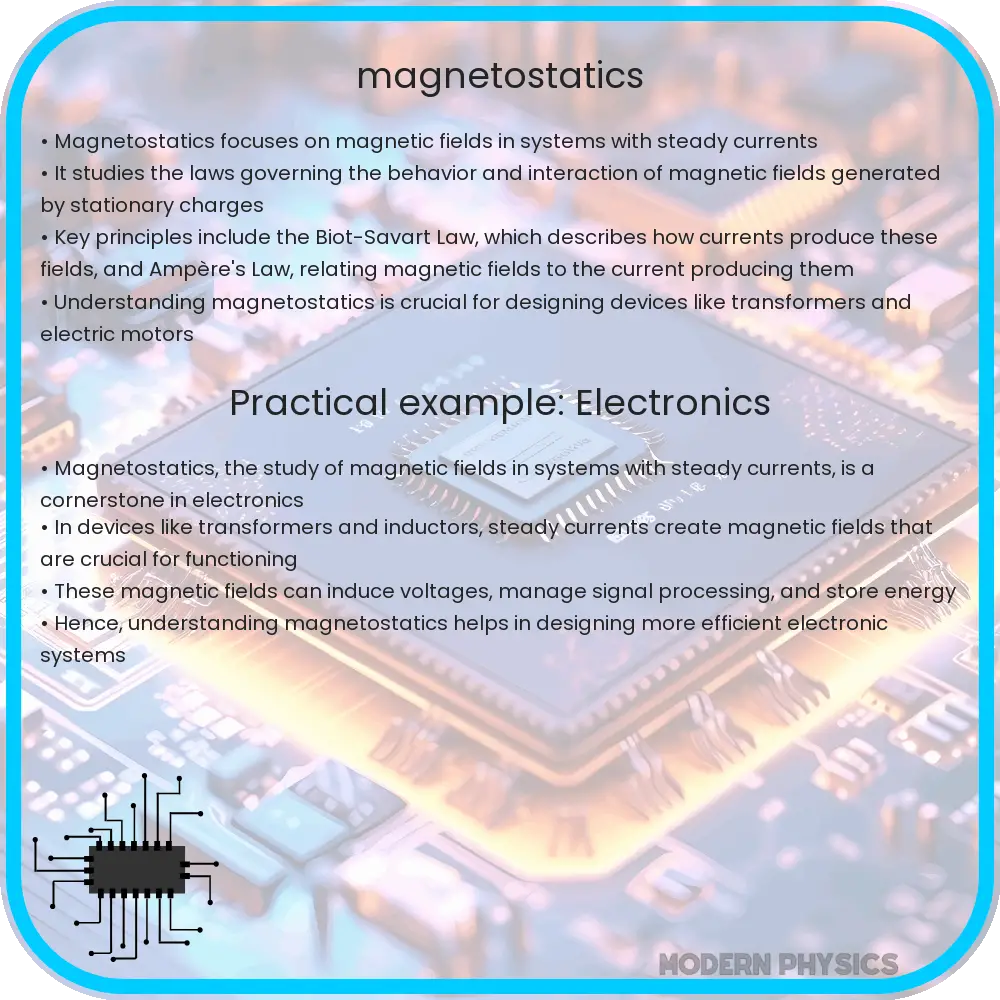Explore magnetostatics, its fundamental laws, applications, and future trends. Understand how it shapes technology and scientific research.

Magnetostatics: An Overview
Magnetostatics, a branch of electromagnetism, focuses on magnetic behaviors in systems with steady currents and static magnetic fields. Unlike electromagnetism, which deals with dynamic fields, magnetostatics explores phenomena where the electric field does not change over time.
Fundamental Principles of Magnetostatics
At the heart of magnetostatics are two core laws: Ampère’s Law and Gauss’s Law for Magnetism.
- Ampère’s Law: Mathematically represented as
∠B · dl = μ0Ienc, whereBis the magnetic field,dlis the differential element of the loop,μ0is the permeability of free space, andIencis the current enclosed by the loop. This law relates magnetic fields to the currents producing them. - Gauss’s Law for Magnetism: States that the magnetic field
Bhas no divergence, i.e.,∇ · B = 0. This law implies that magnetic monopoles do not exist, and magnetic field lines form closed loops.
Applications of Magnetostatics
Magnetostatics finds applications in various fields, significantly impacting technology and industry.
- Magnetic Storage Devices: Hard drives and other magnetic storage media use magnetostatic principles to store data.
- Electromagnets: These devices rely on magnetostatic principles to create controlled magnetic fields, useful in motors, generators, and transformers.
- Medical Imaging: Techniques like Magnetic Resonance Imaging (MRI) are based on magnetostatic concepts, allowing for non-invasive internal body imaging.
Theoretical Aspects
Magnetostatic theory provides a foundational understanding of magnetic fields and their interactions with materials. It involves the study of magnetic field strength, direction, and the influence of different materials on magnetic properties. Theoretical models and simulations in magnetostatics aid in the development of more efficient and powerful magnetic devices.
Magnetostatics, though a subset of electromagnetism, plays a crucial role in our understanding of magnetic phenomena and the advancement of technology. Its principles and applications continue to be integral in various scientific and industrial domains.
Advanced Concepts in Magnetostatics
Delving deeper into magnetostatics, several advanced concepts emerge as crucial for a comprehensive understanding:
- Magnetic Flux and Flux Density: These concepts describe the quantity and concentration of magnetic field lines passing through a given area. Magnetic flux is denoted as Φ and is measured in webers (Wb), while flux density (B) is measured in teslas (T).
- Magnetic Field Intensity and Permeability: Magnetic field intensity (H) is the measure of the strength of a magnetic field generated by a current, independent of the medium. Permeability (μ) quantifies how a material affects the magnetic field within it.
- Boundary Conditions in Magnetostatics: These conditions describe how magnetic fields behave at the interface of two different materials. They are essential for solving complex magnetostatic problems in material science and engineering.
Challenges and Future Directions
Despite its established principles, magnetostatics faces challenges and evolving trends:
- Material Innovations: Discovering materials with unique magnetic properties can lead to breakthroughs in data storage, energy, and sensor technology.
- Integration with Other Fields: Combining magnetostatic principles with nanotechnology, quantum mechanics, and other advanced fields holds promise for innovative applications.
- Environmental Impact: The manufacturing and disposal of magnetic materials and devices raise environmental concerns, driving research towards sustainable practices.
Conclusion
Magnetostatics, a fundamental aspect of electromagnetism, offers profound insights into the behavior of magnetic fields in static conditions. Its principles underpin many modern technologies, from data storage to medical imaging. The field continues to evolve, with ongoing research addressing challenges and exploring new frontiers. As we advance, the integration of magnetostatic principles with emerging technologies and sustainable practices will undoubtedly lead to further innovations, benefiting various scientific and industrial sectors. In conclusion, magnetostatics not only enriches our understanding of the magnetic aspect of the physical world but also continues to be a cornerstone in the development of future technologies.
